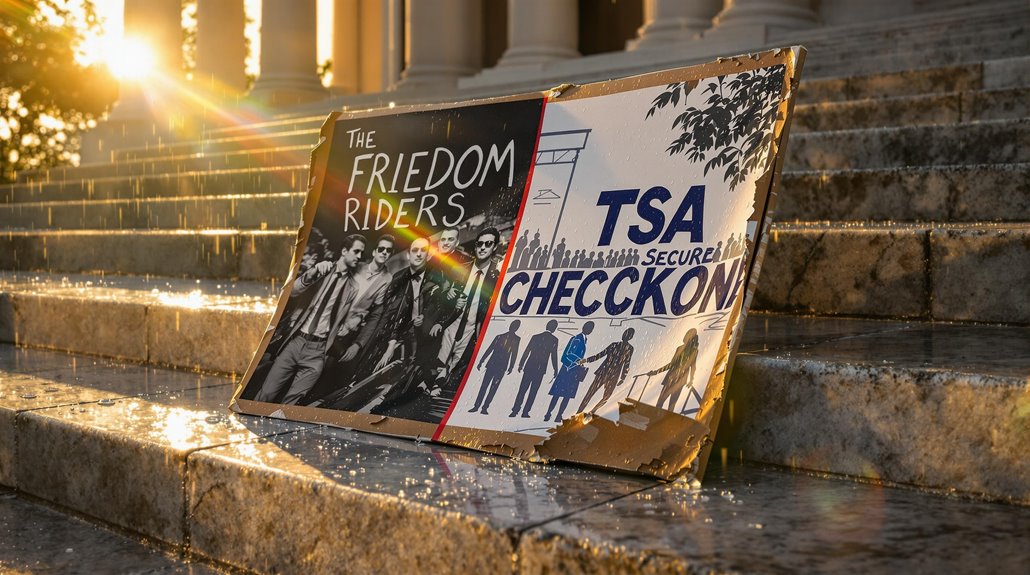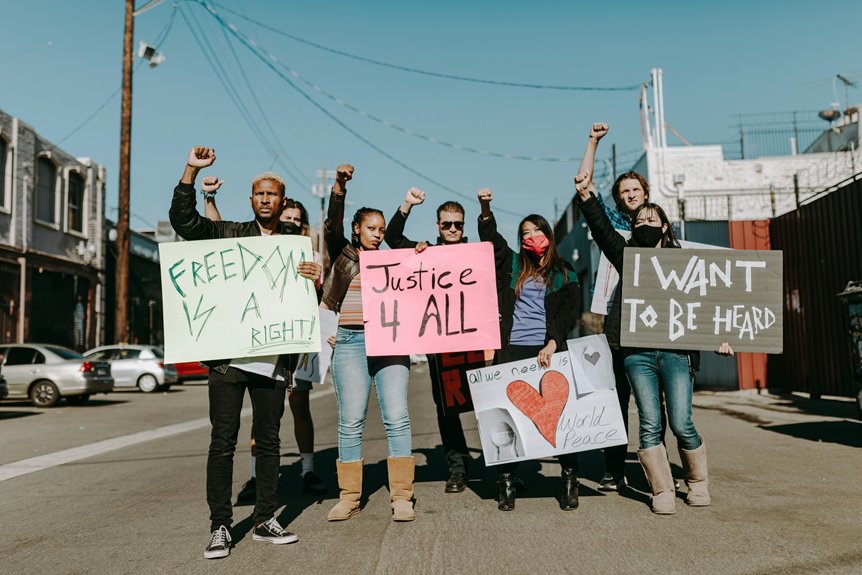Your civil liberties protect you from government interference in fundamental freedoms like speech and religion, while civil rights guarantee equal treatment and protection against discrimination based on characteristics like race and gender. The Bill of Rights safeguards civil liberties through limiting government power, whereas civil rights stem from the 14th Amendment and require active government enforcement. Understanding these distinctions reveals how both work together to secure your place in American democracy.
Defining Civil Liberties and Civil Rights

While many use these terms interchangeably, civil liberties and civil rights represent two distinct legal frameworks that shape America’s democratic foundation.
You’ll find that civil liberties are your fundamental freedoms protected from government interference – like your right to free speech, religion, and due process. They’re fundamentally limitations on government power.
Civil rights, however, operate differently. They’re your guaranteed protections against discrimination, ensuring equal treatment in public places, education, employment, and housing.
You’re protected from discrimination based on race, gender, religion, or national origin. While civil liberties shield you from government overreach, civil rights empower you to demand fair treatment from both government and private entities.
Understanding this distinction isn’t just academic – it’s vital for knowing when and how to assert your constitutional protections.
The Constitutional Foundation of Both Concepts
The Bill of Rights, ratified in 1791, established your fundamental civil liberties as safeguards against government overreach and tyranny.
You’ll find that the Due Process protections in the Fifth and Fourteenth Amendments serve as critical constitutional gatekeepers, ensuring the government can’t arbitrarily deprive you of life, liberty, or property.
The Equal Protection Clause of the Fourteenth Amendment, perhaps the most transformative addition to the Constitution, guarantees you’ll receive equal treatment under the law regardless of race, gender, or other characteristics – though America’s journey to fulfill this promise continues to unfold.
Bill of Rights History
Following ratification of America’s Constitution in 1788, prominent citizens and state governments demanded stronger protections for individual liberties against federal overreach. You’ll find that Anti-Federalists, led by figures like George Mason and Patrick Henry, refused to support the Constitution without explicit guarantees of personal freedoms.
The historical context reveals a fierce debate that shaped America’s future. James Madison, initially resistant to these demands, ultimately championed what would become the Bill of Rights.
You’re witnessing, through documented records, how he drafted seventeen proposals, drawing from Virginia’s Declaration of Rights and other state constitutions. Congress then consolidated these into twelve amendments, of which ten were ratified by 1791.
The resulting Bill of Rights wasn’t just a concession—it became the cornerstone of American civil liberties.
Due Process Protection
Under both the Fifth and Fourteenth Amendments, America’s due process protections serve as the bedrock foundation connecting civil liberties with civil rights. You’ll find these legal safeguards embedded in every level of the justice system, from arrest procedures to court proceedings.
| Protection Type | Civil Liberty Impact | Civil Right Impact |
|---|---|---|
| Procedural | Fair trial guarantees | Equal treatment |
| Substantive | Personal freedoms | Group protections |
| Administrative | Privacy rights | Public access |
When you’re facing government action, due process guarantees you’ll receive notice and a fair hearing. These protections don’t just shield your individual freedoms – they’re essential safeguards against discrimination and abuse of power. You can’t separate due process from either civil liberties or civil rights; they’re inextricably linked through Constitutional guarantees that protect both personal autonomy and equal treatment.
Equal Protection Clauses
While enshrined in the Fourteenth Amendment, Equal Protection Clauses serve as America’s constitutional backbone for defending both individual liberties and group rights.
You’ll find these protections guarantee that no state can deny you equal protection under the law, regardless of race, gender, or social status.
The legislative intent behind these clauses couldn’t be clearer – to prevent discrimination at every level of government.
You’re entitled to fair treatment in education, employment, and housing.
When states try to create laws that treat certain groups differently, they must prove a compelling government interest.
Yet you’ll notice how some jurisdictions still attempt to circumvent these protections through subtle policy changes.
That’s why courts consistently scrutinize laws that might impact different groups disproportionately, even when discrimination isn’t explicitly stated.
Key Differences in Legal Protection and Enforcement
Despite sharing terminology and overlapping goals, civil liberties and civil rights possess markedly different legal frameworks for protection and enforcement. You’ll find that civil liberties stem from the Constitution’s Bill of Rights, while civil rights emerge from subsequent amendments and legislation. The enforcement mechanisms differ dramatically in scope and application.
| Aspect | Civil Liberties | Civil Rights |
|---|---|---|
| Primary Source | Constitution | Federal/State Laws |
| Enforcement | Courts | Gov’t Agencies |
| Legal Action | Individual vs. Government | Individual vs. Individual/Entity |
When you’re facing a civil liberties violation, you’ll typically engage directly with the courts. However, for civil rights issues, you’ll often work through agencies like the EEOC first. This distinction affects everything from filing procedures to remedies available, shaping how you’ll navigate each type of claim.
Historical Evolution in American Democracy

Your nation’s civil liberties emerged from colonial resistance to British tyranny, when early Americans fought against unreasonable searches, religious persecution, and censorship of the press.
You’ll find that while the Constitution’s Bill of Rights initially protected individual freedoms from federal overreach, it wasn’t until after the Civil War that the 14th Amendment dramatically expanded these protections against state governments.
The transformation you’ve inherited reflects a hard-won battle spanning generations, where civil rights warriors leveraged constitutional amendments, Supreme Court decisions, and protest movements to establish today’s framework of protected liberties and enforceable rights.
Colonial Roots of Liberty
Although colonial Americans inherited English common law traditions, they rapidly developed their own distinctive vision of individual liberty that would later shape the nation’s founding principles.
You’ll find that colonial governance structures, while initially mirroring British models, evolved to emphasize local control and individual rights. The liberty origins you’re studying weren’t simply transplanted from England – they emerged from the colonists’ unique circumstances and challenges.
In the decades before independence, you’d have witnessed a remarkable transformation. Colonial assemblies began asserting their authority against royal governors, while town meetings became laboratories for democratic participation.
The distance from England forced colonists to develop their own interpretations of rights and freedoms. They’re innovations you’ll recognize in today’s Bill of Rights, including protections for religious freedom and property rights.
Constitutional Transformation Post-1865
When the Civil War ended in 1865, America’s constitutional framework underwent its most radical transformation since the nation’s founding. You’ll find that these post-war reforms redefined citizenship through constitutional amendments, forever changing how we view civil liberties and rights.
| Amendment | Year | Key Impact |
|---|---|---|
| 13th | 1865 | Abolished slavery |
| 14th | 1868 | Guaranteed citizenship |
| 15th | 1870 | Protected voting rights |
Look closely at how these changes reshaped America’s legal landscape. The 14th Amendment’s equal protection clause became the foundation for modern civil rights litigation. You’re benefiting from this transformation today, as these amendments converted abstract ideals of equality into enforceable constitutional guarantees. The reforms didn’t just expand rights – they fundamentally altered the relationship between federal and state governments, creating new protections you can rely on against discrimination.
Major Supreme Court Cases That Shaped Both

Throughout American history, landmark Supreme Court cases have fundamentally redefined both civil liberties and civil rights. You’ll find that landmark rulings like Brown v. Board of Education (1954) dismantled legal segregation, while Gideon v. Wainwright (1963) guaranteed your right to legal counsel.
These judicial interpretations haven’t just clarified constitutional principles – they’ve transformed American society.
When you examine cases like Miranda v. Arizona (1966), you’ll see how the Court balanced public safety with individual protections. The ruling’s impact reaches into your daily life, as it’s why you hear those familiar “rights” being read on every police drama.
The Court’s decisions in cases like Obergefell v. Hodges (2015) continue to expand civil rights protections, proving that constitutional interpretation remains a living, breathing process.
The Role of Government in Each Category
Supreme Court rulings set precedents, but the government’s role in protecting civil liberties versus civil rights couldn’t be more distinct. You’ll find that civil liberties require governmental limitations, while civil rights demand government authority to guarantee equal treatment. The contrast is striking when you examine how these protections work in practice.
| Aspect | Civil Liberties | Civil Rights |
|---|---|---|
| Government’s Primary Role | Restrict government power | Enforce equal treatment |
| Enforcement Method | Constitutional boundaries | Legislative action |
| Source of Authority | Bill of Rights | Federal/state laws |
| Compliance Type | Passive non-interference | Active protection |
| Implementation | Court restraints | Agency oversight |
You’re witnessing this dynamic play out daily, as federal agencies actively protect civil rights while courts continually check government overreach against civil liberties.
Current Challenges and Modern Interpretations
Modern interpretations of civil liberties and rights face unprecedented challenges in today’s digital age. You’ll find that digital privacy concerns have created new battlegrounds where personal freedoms clash with security interests. Your data’s being collected, analyzed, and shared at an alarming rate, often without your explicit consent.
Social justice movements have transformed how we view civil rights enforcement. You’re witnessing traditional protections evolve as technology reshapes society’s landscape. What once seemed like clear-cut distinctions between liberties and rights now blur in virtual spaces.
Your right to free speech meets complex content moderation policies, while your freedom of assembly extends into online platforms. These emerging challenges force you to reconsider how we’ll protect both individual liberties and collective rights in an increasingly interconnected world.
The solutions aren’t simple, but they’re urgently needed.
Navigating Your Rights as a Citizen
Understanding your rights as a citizen demands constant vigilance in today’s rapidly shifting landscape. You’ll need to actively monitor local legislation, stay informed about Supreme Court decisions, and understand how new policies affect your constitutional protections.
Your citizen engagement starts with rights awareness – knowing when to speak up, when to seek legal counsel, and how to protect yourself from overreach.
You’ll face situations where your civil liberties intersect with others’ civil rights, requiring careful navigation of competing interests. Document everything, maintain detailed records of interactions with authorities, and don’t hesitate to file formal complaints when warranted.
Conclusion
Understanding your civil liberties and civil rights isn’t just academic – it’s essential for traversing today’s complex social landscape. While liberties protect you from government overreach, rights guarantee equal treatment under the law. You’ll need both to fully participate in democracy. Stay informed, document violations, and exercise these protections wisely. Your awareness of these distinct yet complementary concepts strengthens America’s democratic foundation.





